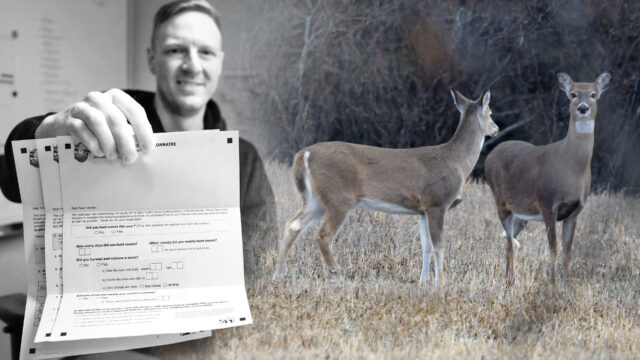Guest Post: Hunter harvest surveys an important tool for Game and Fish

Guest post from North Dakota Game & Fish outreach biologist Doug Lier.
Do you feel like everywhere you turn there’s something trying to get your attention? Spam phone calls, robo calls, junk text messages. The other day I noted advertisements in the bathroom. It got me to stop and think. So, it worked.
When it comes to email, my inbox gets filled up. Just like yours. At times it’s overwhelming. Sometimes I make a point to return and make sure I haven’t missed important correspondence. A few weeks back I was glad I did as I was selected to complete a hunting survey from the North Dakota Game and Fish Department.
In the eye of surveys and statistics it makes no difference whether you work for the Game and Fish or not. The surveys are completely random. The important part is for those who are surveyed to complete the requested task accurately.
For most surveys, the department selects recipients at random, so the more people who fill out and return the surveys, the better the information.
“We survey hunters about their hunting activity because understanding how many animals were removed from the population is a really important ecological piece of information,” said Chad Parent, department survey coordinator. “We use that information that we get back from the hunter harvest surveys to compare against where we’re at with our harvest objectives at any point in a given year. And that can mean, in some cases, license increases. It can sometimes mean that we decrease the number of licenses, potentially in the case of a site that was hit hard by EHD a couple years ago. But ultimately these surveys are important because they inform the recommendations that we pass along to the governor during the proclamation setting process.”
Thousands of big game, small game, waterfowl, swan, turkey and furbearer questionnaires will be emailed to randomly selected hunters. A follow-up survey will be mailed to those who did not respond to the first survey.
Not everyone who, say, receives a hunter harvest survey for the 2022 deer gun season will have harvested a deer, but Parent stressed that those hunters still need to fill out and return their surveys.
“We design our surveys so that a random sample of hunters get those surveys, and we understand that some hunters weren’t successful, which in a lot of ways is just as important as knowing who did harvest a deer,” he said.
Parent said the hunter harvest surveys are short and take very little time to complete. He added that a follow-up survey will be mailed to those who did not respond to the emailed survey.
“The more surveys we get back from hunters, the more robust the statistical information is to help us produce better harvest estimates,” Parent said. “I equate the hunter harvest surveys to the work we do at Game and Fish. We fly aerial surveys to count deer and we drive roadside surveys to count upland game birds. The more time biologists spend in airplanes or driving North Dakota backroads, the better the estimates we get back. And it’s the exact same concept for hunter harvest surveys.”
We’re fortunate in North Dakota that our hunters are willing to provide accurate survey information, which in turn provides wildlife managers and biologists the best data and information to help make future decisions on hunting seasons.
Hunters who participate in the surveys with accurate, timely responses is a huge benefit to the department. Thanks to all who have filled out surveys in the past and keep an eye on your email inbox for coming surveys.




